Search the Special Collections and Archives Portal
Search Results
Elizabeth Casper Photograph Collection
Identifier
Abstract
The Elizabeth Casper Photograph Collection, approximately 1947 to 1960, contains photographic prints and slides that document the childhood of artist and schoolteacher, Elizabeth Casper, and her family life in Las Vegas, Nevada. Included are images of Casper and her family as well as the Helldorado parade, civic celebrations, churches, a nursery school, and casinos in Las Vegas.
Archival Collection

Sergio "Checko" Salgado oral history interview: transcript
Date
Archival Collection
Description
Oral history interview with Sergio "Checko" Salgado conducted by Laurents Bañuelos-Benitez, Barbara Tabach, Elsa Lopez, and Monserrath Hernández on June 4, 2019 for the Latinx Voices of Southern Nevada Oral History Project. Checko talks about his personal history that led him to pursue journalism and photography. He discusses his education and employment working in art galleries in Denver, Colorado and Las Vegas, Nevada and the various art exhibitions he has designed including in the Marjorie Barrick Museum at the University of Nevada, Las Vegas and in the Reynolds Senate Building in Washington, D.C.
Text
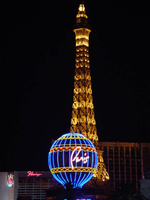
Photographs of Paris signs, Las Vegas (Nev.), 2002
Date
Archival Collection
Description
Site name: Paris Las Vegas Hotel & Casino
Site address: 3655 S Las Vegas Blvd
Sign owner: Park Place Entertainment
Sign details: The Paris property lies on the east side of Las Vegas Blvd, between the Aladdin and Bally's. The three properties stretch from Harmon Avenue, all the way to Flamingo Rd. The only real neon signage includes the text seen on top of the replica of the Eiffel Tower, and a three-dimensional balloon shaped pylon sign located at the south end of the property.
Sign condition: Structure 5 Surface 5 Lighting 5
Sign form: Pylon; Fascia; Porte-cochère
Sign-specific description: Leaving the Aladdin property, headed north you are immediately confronted with the giant hot-air balloon, which acts as the main marquis sign for the Paris Hotel and Casino. The three-dimensional balloon shape sits among trimmed shrubbery and foliage, representational of a classic French garden. The sign is located on an island with a long driveway on its north side running east into the property. It towers high above the viewer, almost appearing as if it is floating. In the spirit of properties like the Aladdin and the Excalibur, the facade of the resort is modeled after a theme, which is the French City of Paris. Complete with fountains, replica street fronts and markets, the main focal point is a life size replica of the Eiffel Tower. Some signage is located high up on the tower, in yellow channel letters. The sign reads "Eiffel Tower Restaurant." The three-dimensional sculpted pylon sign is composed of basically three pieces. At the very bottom, a large post holds up the second section of a large cube. All four sides of the cube are occupied by square, advertising screens. The two facing east/west are back lit color plastic, while the ones facing north/south are LCD screens. The cube is finished in stucco, with sculptural treatments along all of the edges of the cubes. The edges are made to look like giant ropes with knots on all eight corners. The sign is located on the East Side of the strip, yet the only directional orientations are on the cube that the balloon sits on. The spherical structure is an exterior frame with blue vinyl material stretched to form the balloon shape. Steel framework also runs around the circumference in six different places along the structure. On the north and south sides Paris is spelled in red channel letters, filled with incandescent bulbs and bordered in neon. The blue vinyl material is treated with graphic painted images, which are repeated around the circumference of the balloon. The images are of lion heads holding red sashes, above golden eagles. On the middle section an image of a woman's face is surrounded by a golden halo. The yellow structural supports, which are visible on the exterior, also house tubes of neon. The resulting effect is a repeating pattern of neon running up the length of the structure, with horizontal bands around the bottom of the structure, below the channel letters and above them also. A criss-cross pattern adorns the two bands below the text, as well as a scalloped pattern above the text also. The porte cochere is a circular drive with the only lighting being incandescent bulbs running along the raceways, which create the structure of the interior. The structure is finished in a patina bronze, made to look oxidized.
Sign - type of display: Neon; Incandescent
Sign - media: Steel; Plastic
Sign - non-neon treatments: Graphics; Paint
Sign animation: Chasing, flashing, oscillating
Notes: The incandescent bulbs inside the text reading "Paris" on the balloon oscillate rapidly.
Sign environment: Located between Bally's and the Aladdin, two heavily frequented and boisterous properties themselves, the Paris fits nicely creating it's own environment that stands alone when entered. If a pedestrian is present among the stunning architecture, it is easy to be pulled into the theme. Even though the Bellagio is west across the street, the expanse of the street keep the Paris far enough away to be mostly independent, that is of course if the Bellagio's water show is not being displayed. The surrounding properties of Bally's, the Aladdin, and The Bellagio make the area of Las Vegas Blvd between Harmon Ave. and Flamingo rd. a fantastic world stylized cities and dazzling imagery, yet an interesting mix of architecture and signage.
Sign designer: Architect/consultant: Bergman, Walls & Youngblood Ltd. Contractor: Perini Building
Sign - date of installation: 1997
Sign - thematic influences: The Paris Hotel Casino is obviously themed after the actual French city of Paris. The entire facade represents the Parisian atmosphere containing the most famous of Parisian attractions including the Eiffel Tower, the Arch de Triumph, open air cafes, plazas utilizing fountains, and the ornate architecture that spans from gothic to neo classical. The Paris fits into the themed hotel casino industry seamlessly, actually boasting one of the more ornate and unique facades. Other properties that parallel the Paris in style and genre include the Aladdin, the Venetian, and the New York New York. In fact it fits into the category of Hotel/Casino whose theme is what dominates the aesthetic surroundings as well as operation inside and out. Other facilities contain elements of a theme, such as the Stardust, but the interior and exterior are no longer the dominant aspect of the aesthetics. It also fits into the category of resorts themed after actual cities.
Surveyor: Joshua Cannaday
Survey - date completed: 2002
Sign keywords: Chasing; Flashing; Oscillating; Pylon; Fascia; Porte-cochère; Neon; Incandescent; Steel; Plastic; Paint; Graphics
Mixed Content
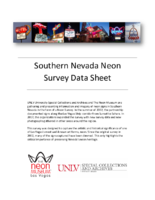
Bunkhouse Saloon Neon Survey document, August 23, 2017
Date
Archival Collection
Description
Site address: 124 S 11th St
Sign owner: 11th Street Tavern LLC and Jillian is the manager (no last name found)
Sign details: This location opened in 1953, but has recently reopened under new ownership. This location is known for their concert venue as well as their southern style bar food.
Sign condition: 3-4- some fading in the plastic so it does not show as clear as an image as it could.
Sign form: Pylon
Sign-specific description: This sign has a black steel base with a sign box on top. This sign box is steel but has wood renderings on the sides of it. The sign box contains a back lit plastic sign that is red with yellow lettering that states "The Bunkhouse Saloon" in a swirly western font. Below this is a reader board.
Sign - type of display: Backlit plastic sign and reader board
Sign - media: Steel, wood and plastic
Sign - non-neon treatments: Plastic backlit sign and readerboard
Sign environment: This location is downtown on East Fremont across the street from PublicUs and a food market.
Sign - thematic influences: Their saloon theme is portrayed in the font on their sign. This theme could also pay homage to the early Las Vegas and Old West theme with the saloon idea.
Survey - research locations: Asessor's Page, Bunkhouse website http://www.bunkhousedowntown.com/about/ and google images.
Survey - research notes: Tried to contact manager for information on sign but no response.
Surveyor: Wyatt Currie-Diamond
Survey - date completed: 2017-08-23
Sign keywords: Pylon; Plastic; Backlit; Steel; Reader board
Text
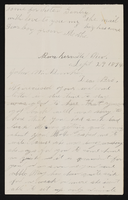
Letter from Francis M. Bunker and John M. Bunker's Mother, Bunkerville, Nevada to John M. Bunker
Date
Archival Collection
Description
From the Syphus-Bunker Papers (MS-00169). The folder contains an original handwritten letter, a typed transcription of the same letter, and a copy of original letter attached.
Text
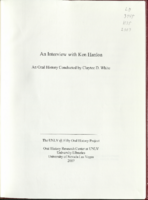
Transcript of interview with Ken Hanlon by Claytee D. White, November 29, 2006
Date
Archival Collection
Description
Text
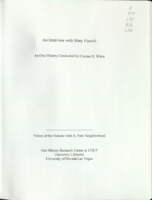
Transcript of interview with Mary Hausch by Claytee D. White, April 7, 2009
Date
Archival Collection
Description
Text
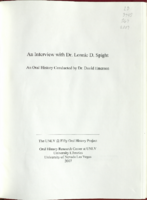
Transcript of interview with Dr. Lonnie D. Spight by Dr. David Emerson, May 8, 2007
Date
Archival Collection
Description
Text
J. T. McWilliams Family Papers
Identifier
Abstract
The collection consists of letters, greeting cards, survey maps, newspaper clippings, legal papers, photographs, collected recipes, land sales and expense journals, and survey reference books. The material was created or collected by pioneering Nevada surveyor, engineer, and real estate entrepreneur J. T. (John Thomas) McWilliams and his wife, Iona, between 1900 and 1968.
Archival Collection
Las Vegas High School Architectural Drawings
Identifier
Abstract
The Las Vegas High School architectural drawings include blueprints for various improvements, expansions, additions, and renovations performed for the Las Vegas, Nevada high school between 1929 and 1972. The architectural drawing sets include site plans, floor plans, elevations, sections, building component details, and structural drawings.
Archival Collection
